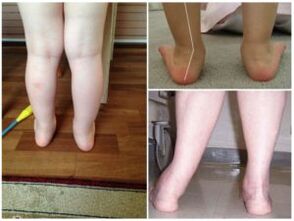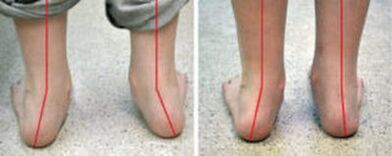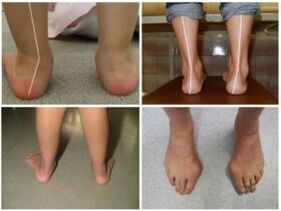Parents should pay close attention to the physical development of their children to adjust the deficiencies on time.The deformation of the feet of the foot in children is a frequent pathology.Although the defect is congenital or acquired, diagnostic, prevention and correction methods are similar.
What is a valge and a flat fence foot?

The term Valgo doctors denotes any curvature of the joints within the conditional midline (axis), in which a marked deviation is noted "in the form of X".The most pronounced example of pathology is the bones in the thumbs (Hallux Valgus).The deformation of the valgo, which is abbreviated as "feet of valgo" (sun) is the incorrect configuration of the foot in horizontal support.If the One Baby -and gather the legs, then the back is remarkable since the internal ankle moved closer to the opposite limb, and the heel was diverted outside.At the same time, a flat child is mainly based on the internal (medial) of the foot.Therefore, the plantar region, so to speak, "look."A variety of the disease is a flat fence foot (PVS).It combines flat feet with X -shaped curvature. In the baby, in addition to deformation formation, the whole foot is gradually flattened.
Valgo's degree of curvature
The negligence stage of the pathology is determined by the size of the heel deviation of the medium axis.
There are 4 degrees of disease:
- I - up to 15 °;
- II - 15─19 °;
- III - 20─29 °;
- IV - 30 ° or more.
Stage 1-2 of the deformation of the valgo can be eliminated by conservative methods.With 3 degrees, prolonged treatment is needed.In 4 stages, surgical correction may be required.
The causes of deformation
There are three factors, as a result of which there is a curvature of the foot: deteriorated intrauterine development, chronic physical overload, musculoskeletal system diseases.These factors weaken ligaments, tendons, muscles, so the foot is not fixed by them in a normal anatomical position.
The reasons of the acquired valge, the flat valga foot (M21.0 code in ICD-10):
- Premature configuration in the legs, when the baby's joints are not yet ready for such loads;
- "Incorrect" shoes (narrow block with a high thin heel, without supinators).
- Muscle hypotension, congenital mini -disease;
- Great weight, obesity;
- rickets;
- Neuromuscular diseases (polio, child cerebral palsy, polyneuropathy of various etiologies);
- Congenital dislocation of the thigh and dysplasia of the hip joints;
- trauma at the foot or at the bottom of the leg;
- Long -term immobilization of the leg with plaster, tutor or pillow of Freik.
The congenital origin of the valgo and the defect of the flat valge of the structure of the foot (code Q66.6 in the ICD-10) may be due to an lesion in the abdomen transferred by a pregnant woman, or a genetic disease.Such curvature can be seen immediately after birth, sometimes manifests before the baby begins to walk.
How to determine the deformation of the stop

A change in the lower limb configuration along the axis of the leg is established.This is the name of the conventional line, visually drawn from the center of the hip joint through the knee, the ankle to the middle of the calcaneus.The norm implies the passage of the axis through the center of the joints that should not move from it to the right or left.
Characteristic characteristic
In newborn babies, with the innate nature of Valgus, it is immediately or in the first months of life.Very often, the signs of a valgo defect in children appear after a year and a half.The presence of ailment can suspect for the behavior and march of the baby.Very often, there are the following general symptoms of pathology:
- greater flexibility of small joints;
- decrease in the height of the sole assembly;
- The displacement of the center of gravity (when trying to walk, the child is based only on the medial side of the foot, its outer edge can rise slightly);
- Uncertain, dragging the march;
- Fast physical fatigue, the need to rest, to give the baby to relax;
- Regular complaints about leg pain, lack of will to walk;
- light swelling and redness of the skin on the foot and ankle;
- Desigual shoes wear, more expressed from the inner edge of the sole.
Methodology to identify deformation
Defect diagnosis methods include an exam with an orthopedic of the baby's foot, followed by the baby's address for an instrumental exam.An X feet is made in three projections to discover the degree of bone displacement.They also carry out a planetography to determine the height of the ardor and the degree of severity of the flat feet.Using the subway post, the pressure center is calculated on the sole.This is an effective diagnostic method, since it allows you to identify Valgo deformations in the early stages.Sometimes, to clarify the exam results, an ultrasound of the foot is performed.The visual signs of the pathology are the only one, slightly rotated and elevated in the lateral direction, the displacement of the heel, out from the midline.With the deformation of the flat values, the disappearance of the vault, the flattening of the foot is observed.To exclude the neurological causes of the defect, the orthopedist directs the child to a narrow specialist.
Correction methods
To eliminate the valgo, the main tasks are to give the foot of the correct position and the subsequent strengthening of the ligaments attached to the heel and the muscle tendons.
Joint setting in a conservative way
With an innate defect, dressings or plaster guardians are used.The purpose of rigid foot fixing in the correct angle is to eliminate the curvature by immobilization.While ossification is not completed, fabrics are elastic, so they are easily susceptible to such correction.With the acquired valge defect, to return the correct configuration of the foot, orthopedic shoes are made to the child.It should not cause discomfort when used.A special shoe template has rigid side supercinators, a soft pillow (rates) under the foot vault.It is also recommended to use these shoes during rehabilitation after surgery and to consolidate the treatment results.
A variety of templates with one foot Valgus
Experts recommend ordering orthosis, shoes or templates for children in orthopedic halls according to individual sizes and foot molds.The product price will be slightly higher, but the use will give a more notable result.
Strengthen small joints

For the general hardening and the tonic muscles of the lower extremities, it is recommended to use contrasting feet baths.For this, the feet are submerged alternately in a container with hot and cold water.They start with a temperature of 36 ° C with a liquid, then this value changes every week in 1 ° C, with a range of 14 to 40 ° C.
It is useful to do the following exercises:
- walk alternating on socks, heels, external and internal edges of the sole;
- Collect small objects, grab cloth or paper, draw with the fingers of the feet;
- Put the sole ball on the floor;
- a set of fingertips (flexion, reproduction and closure extinction);
- Walking on pebbles and an irregular surface.
The orthopedist can prescribe a massage course of the lumbar column, affected by the lower limb or both legs.It is optimal to carry it out after heating with paraffin or ohkeritic application.The muscles of the internal surface of the legs are acted by tonic massage movements (palmaditas, kneading).The outer surface of the legs must massage with relaxation techniques: caressing, rubbing.
Physiotherapeutic procedures
If the deformation of the foot caused the inflammation of the joint structures, muscles tendons, the child is prescribed electrophoresis with analgesics and anti -inflammatory medications, magnetotherapy, black wax application, paraffin and therapeutic mud.For selective muscle stimulation, diadernamal currents are used.
Surgical treatment
In early childhood, radical therapy methods are not used.But if the defect interferes with the normal walk, the operation is performed on young children.During the surgical intervention, doctors who use metal elements (titanium wire, screws, plates) fix the deformed joint in a normal position.Surgeons can also strengthen the articulation by moving the fibula tendon or lengthening the Achilles tendon.After these operations, rehabilitation includes the use of orthopedic products, massages, physiotherapy and physiotherapy exercises.
Preventive measures
To avoid the deformation of the feet, you must buy a child in comfortable shoes corresponding to the size of the leg, the anatomical structure of the foot.How to choose: Look at the recommendations of E.O.Komarovsky in the video.The doctor says about the disease that this is a frequent violation in children and helps to form the foot that will be formed until the age of 12.The teenager probably needs an operation to correct the pronounced defect of the foot.The child must walk barefoot on sand, grass, walk a lot, eat completely.Taken from the sun avoids rickets in children, which is one of the causes of the disease.Physical Education, Body hardening, Regular Courses of General Strengthening Massage.Gymnastics for foot muscles is also important, including the creation of a leg pattern in the sand.Outdoor active games, swimming also contributes to strengthening the muscles and ligaments of the lower extremities.All these measures prevent the development of foot defects.It is forbidden to put on the child's legs up to 7.5 Gra .8 months, when the joints and bones of the lower extremities have not yet strengthened.It is unacceptable to lose the planned exams of the pediatrician and narrow specialists, which allows him to identify the pathology at an early stage.
Doctors 'responses to parents' questions
How to warn the deformation of the congenital valge?Unfortunately, the vice of the development of the musculoskeletal system cannot be prevented.Even if they found no deviation in the hospital, the baby must be regularly inspected by a pediatrician, receive massages, walk barefoot on an unequal but safe surface for the legs.At home, it is recommended to use a massage carpet.The acquisition of high quality shoes also helps to set foot in the correct position, to form a set of physiological heights.This prevention will stop the progression even of the foot of congenital valge.
What doctor is the pathology?
If necessary, the pediatrician directs the baby to the orthopedist, traumatologist and surgeon of the children.
What is a varior foot?
Varus deviations are the displacement of the heel bone inside the midline.In this case, the set of foot is very high, and the pressure center moves to the outer edge of the sole.A defect is treated with the same methods as the deformation of the valgo, only the deviation angle is adjusted from the opposite side of the foot.
Foot valge deformation: consequences and correction
The deformation of the feet is a pathological change in the musculoskeletal system, in which the height of the foot of the foot decreases, and the axis of the lower extremities changes.
The defect can be congenital or develop in childhood, which leads to the flat feet, the violation of the position and other health problems.As a general rule, it conservatively adjusts, in the course of a long therapy with load, massages, physiotherapy.With regular work on deformation, you can achieve proper configuration of the leg and safe march.
Deformation of the feet of the feet in children-symptoms
This leg defect can be recognized by the following external signs:
- The foot is full of internal rib, the child rests on the inner part of the foot;
- The heel and fingers unfold out;
- The middle part of the foot is flat or remarkably low;
- When the knees are reduced, the legs acquire an IX eyebrow form, the legs do not converge together, including the distance of approximately 4-5 cm remains;
- Uncertain and clumsy gait, the child often stuck, deck;
- The child quickly tires a walk.

When can a defect manifest?
The arc of the foot begins to form from the moment the baby tries to take the first steps.For babies, a flat foot is considered the norm.By assuming a vertical position independently, children develop a musculoskeletal system, "accustomed" to new functions.The bones and ligaments begin to experience loads, the foot is strengthened and takes the correct anatomical form.This generally occurs up to 1.5 years.If for this age the vaults remain flat, there is no formed curve, doctors define this as deformation of the feet.As a general rule, violations in medical exams are detected, but if the parents independently noticed the previous signs, they must immediately contact an orthopedic.If the adjustment begins as soon as possible, the restoration is faster and without serious consequences.
Conclusion
Parents must dedicate the maximum time to the prevention of defects in the physical development of the baby, including gymnastics, massage courses and other recreational activities.If the deformation of the feet valge in children is not eliminated by conservative treatment, then you must accept surgical intervention to correct the shape of the foot.After all, advanced pathology is full of ostero development, spine diseases and limb shortening.























